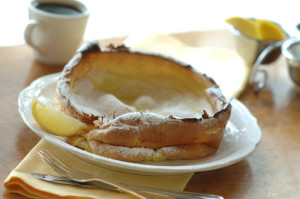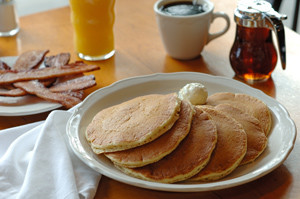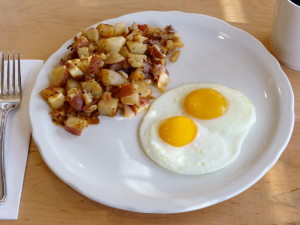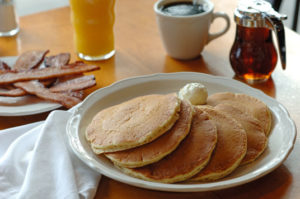Food Battle: Bacon vs. Breakfast Sausage
What is better, sausage or bacon?
When it comes to the battle of the breakfast meats, bacon vs. breakfast sausage, which team are you rooting for? When you take into account that 908 million pounds of bacon were sold in 2015, you might think that Team Bacon comes out on top. However, a 2016 Harris Poll conducted for the National Hot Dog and Sausage Council found that a majority of Americans, 89% of the respondents, favor sausage overall. The poll found a wide variety in the types of sausage that American diners prefer – Italian and patties tied for favorite among respondents at 20% each with breakfast links at 15% and bratwurst at 12%.

But let’s not diminish the role that bacon plays in our hearts and on the table. 2015 sales of the cured meat totaled $4.21 billion, according to the North American Meat Institute. This was a 5.4% year-over-year increase in sales. And in a survey conducted by pork supplier Smithfield, 65% of people said they would support a petition that declared bacon as America’s national food.
Going back to Team Sausage, from 2011 to 2016, sausage consumption in America steadily rose from 231.88 million consumers to 246.81 million, according to a 2016 Simmons Profile Report.
When it comes to the bacon vs. breakfast sausage battle, at The Original Pancake House in Denver we won’t choose sides because we love them both. We offer a number of delicious choices including honey cured bacon, turkey sausage, and our special recipe sausage patties and links. Visit us soon to taste them and pick a team if you dare!
Our Dutch Baby Makes a Delicious and Unique Breakfast
 Have you tried our Dutch Baby Pancake before? If not, you have really been missing out! This dish isn’t your typical mini Dutch pancake. It is oven baked, rich and fluffy. We serve it with lemon, butter and powdered sugar. The mini Dutch pancake makes for a tasty breakfast that is just slightly off the beaten path.
Have you tried our Dutch Baby Pancake before? If not, you have really been missing out! This dish isn’t your typical mini Dutch pancake. It is oven baked, rich and fluffy. We serve it with lemon, butter and powdered sugar. The mini Dutch pancake makes for a tasty breakfast that is just slightly off the beaten path.
The Dutch Baby, also known as a German Pancake, Bismarck or Dutch Puff, is more like a popover than a traditional pancake. It is a descendant of the German pancake called Pfannkuchen. A batter made with lots of eggs plus milk, flour, sugar, and vanilla is poured into a cast iron skillet that has been preheated in the oven. The Dutch Baby puffs up very tall like a soufflé when baked in the hot oven, then it falls when it is removed. The resulting dish is rich and eggy, almost custard-like in the center, with crispy brown edges. It is truly a culinary treat!
The Dutch Baby pancake is one of our specialties at The Original Pancake House. We like it served the traditional way but if you want to try making one at home you could dress it up many different ways. They are delicious with fresh fruit and fruit sauces, butter and maple syrup, peanut butter and jam, or yogurt and berries. You could even leave the sugar out of the batter and top your mini Dutch pancake with savory items like bacon and eggs.
The Many Lives of the Pancake Breakfast
Flapjacks vs pancakes vs hotcakes…are they relatives of the pancake?
Pancakes are a very popular choice for breakfast all over the country. You’d probably have a hard time finding someone who doesn’t enjoy a short stack of fluffy pancakes, topped with butter and maple syrup. They’re equally delicious when served simply, or dressed up in many different ways.
 There are many different names for pancakes including flapjacks, griddlecakes and hotcakes. All of these other names for pancakes are the same basic ingredients and cooking method, they just may be called something different depending on region and the restaurant. Typically, in the U.S. flapjacks and pancakes are the same thing, the name is just used regionally. However, you may find some restaurants calling pancakes that are either a little smaller, or larger, than normal, “flapjacks.” Silver dollar pancakes are simply named for their size. In England, a flapjack is not a pancake at all, but a type of sweet bar cooking made from oats.”
There are many different names for pancakes including flapjacks, griddlecakes and hotcakes. All of these other names for pancakes are the same basic ingredients and cooking method, they just may be called something different depending on region and the restaurant. Typically, in the U.S. flapjacks and pancakes are the same thing, the name is just used regionally. However, you may find some restaurants calling pancakes that are either a little smaller, or larger, than normal, “flapjacks.” Silver dollar pancakes are simply named for their size. In England, a flapjack is not a pancake at all, but a type of sweet bar cooking made from oats.”
A johnnycake is a small pancake made from cornmeal, salt and hot water or milk, rather than wheat flour. Johnnycakes were a staple item for early Americans and now they are very popular in New England, particularly Rhode Island. The South also makes this dish but it is called a hoecake.
Crepes, like those we serve at The Original Pancake House, are very thin pancakes made from flour, milk and eggs. They are very popular in France, Belgium and Switzerland and are served in a variety of ways, both sweet and savory.
Battle Breakfast Restaurants: Hash Browns vs Home Fries
Which do you prefer at breakfast restaurants, hash browns or home fries?
Potatoes show up on the menu at breakfast restaurants almost as much as eggs do. The potato is one of America’s favorite starches and we enjoy them at any time of the day. But potatoes go particularly well with breakfast and show up mostly in the form of hash browns or home fries, the two most popular sidekicks to your eggs.
When it comes to the breakfast battle of hash browns vs home fries, let’s start with the difference between the two. Hash browns (or hashbrowns and hashed browns), are traditionally shredded potatoes that are pan fried to a golden brown. Home fries are made from cubed or diced potatoes. They are fried up along with onions and often bell peppers. Hash browns and home fries are staple items of breakfast restaurants around the country. The first known mention of “hashed browned potatoes” is by food author Maria Parloa in 1888. Over time the name was shortened to its current form.
At The Original Pancake House we prefer home fries because they have more texture as well as more flavor with the addition of onions and seasonings. We think they have a bit more personality and are more “homey” than the simple shreds of hash browns. They make a great side dish to many of our fantastic breakfast dishes.
Breakfast Restaurants are Serving Up Eggs
 How many eggs are consumed in America? Keep reading to find out this and other egg statistics.
How many eggs are consumed in America? Keep reading to find out this and other egg statistics.
Eggs are a staple item at breakfast restaurants and in our homes as well. It’s really no mystery why. They’re the perfect source of complete protein and can be prepared in endless ways. So just how many eggs do you think are being prepared at breakfast restaurants in the United States? In 2015 an estimated 231 million cases of shell eggs were produced. Of that, a whopping 20.8 million cases went to the foodservice industry. That’s a lot of omelettes!
Here’s some more “eggstraordinary” facts about the egg industry.
- As of January 1, 2017 there were 372 million egg-laying chickens (“layers”) in the country.
- Of those 372 million layers, 314 million of them are for producing shell and table eggs.
- Iowa is the number one egg producing state in the country.
- When analyzing the cost of high-quality protein, eggs are the most affordable choice at 55 grams of protein per dollar spent. Compare this to 90% lean ground beef, which provides 16 grams of protein per dollar spent.
- In 2016 per capita consumption of eggs was estimated at 267.4 per person.
- The Guinness World Record for the largest omelette was set in 2012 by a group of Portuguese chefs. They used a total of 45,000 free range eggs to make it and and it tipped the scales at 9,702 pounds and 8 ounces.
The Star of Pancake House Menus Has a Long History
 They may be the preferred item on pancake house menus, but people have been eating them since long before restaurants.
They may be the preferred item on pancake house menus, but people have been eating them since long before restaurants.
Pancakes have long been a favorite of the American breakfast table. You’d be hard pressed to find people who did not grow up enjoying the classic combination of pancakes and maple syrup. But what do you know about the history of the humble star of pancake house menus? You may be surprised to learn that pancakes are actually an ancient dish.
It is believed that the earliest pancakes may date as far back as the Stone Age. These ancient versions weren’t made with flour, but more likely from ground up starchy vegetation that was mixed with water and cooked on a hot stone. This practice of making flat cakes from some form of grain or starch continued throughout history. The ancient Greeks made a version from wheat flour, olive oil and curdled milk. They were sweetened with honey and eaten for breakfast. Another Greek version was made with spelt flour and topped with honey, sesame and cheese.
The modern American pancake evolved from the hoe cakes and johnnycakes of Colonial times. These were made from cornmeal or buckwheat. The first recipes were published in the 1796 cookbook American Cookery by Amelia Simmons.
Today pancakes of all varieties are found in America and many other countries all around the world. They are, of course, still the star of all of The Original Pancake House menus, made from our signature sourdough starter. This gives them the light and airy texture they are known for. Come celebrate culinary history with us any day of the week!
